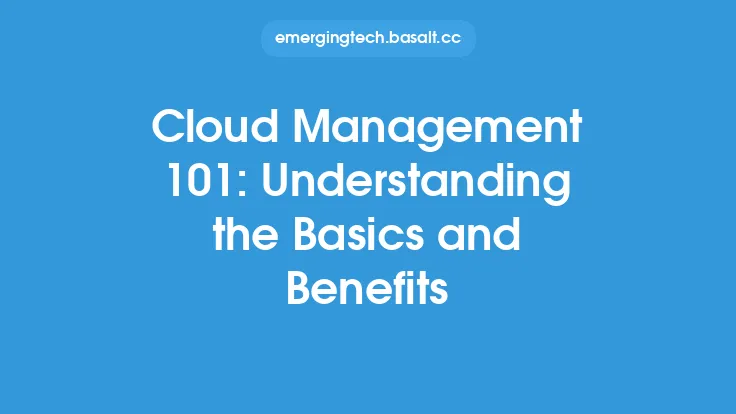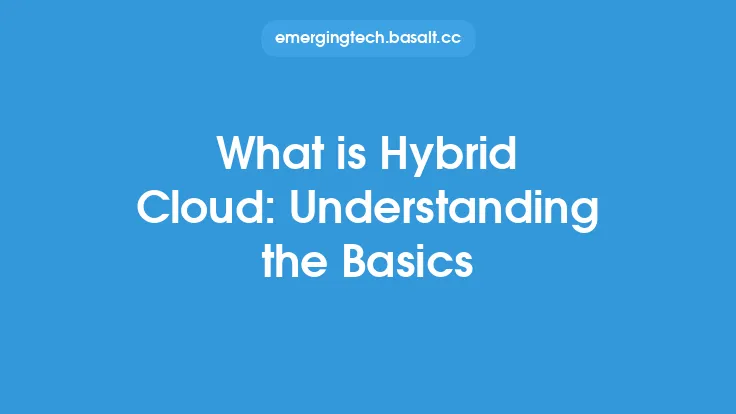In the realm of cloud computing, two terms have gained significant attention in recent years: hybrid cloud and multi-cloud. While both concepts involve the use of multiple cloud environments, they differ in their approach, architecture, and benefits. Understanding the differences and similarities between hybrid cloud and multi-cloud is crucial for organizations looking to leverage the power of cloud computing to drive their digital transformation.
Introduction to Hybrid Cloud
A hybrid cloud is an integrated cloud computing environment that combines public and private cloud services, allowing data and applications to be shared between them. This approach enables organizations to take advantage of the scalability and cost-effectiveness of public cloud services while maintaining control and security over sensitive data in a private cloud environment. Hybrid clouds can be further divided into two sub-categories: hybrid cloud infrastructure and hybrid cloud applications. Hybrid cloud infrastructure refers to the integration of public and private cloud infrastructure, while hybrid cloud applications refer to the deployment of applications across multiple cloud environments.
Introduction to Multi-Cloud
A multi-cloud environment, on the other hand, involves the use of multiple cloud services from different cloud providers, such as Amazon Web Services (AWS), Microsoft Azure, Google Cloud Platform (GCP), and IBM Cloud. This approach allows organizations to avoid vendor lock-in, increase flexibility, and take advantage of the unique features and services offered by each cloud provider. Multi-cloud environments can be further divided into two sub-categories: multi-public cloud and multi-hybrid cloud. Multi-public cloud refers to the use of multiple public cloud services, while multi-hybrid cloud refers to the use of multiple hybrid cloud environments.
Key Differences Between Hybrid Cloud and Multi-Cloud
The primary difference between hybrid cloud and multi-cloud is the level of integration and orchestration between the different cloud environments. Hybrid clouds are designed to provide a seamless and integrated experience between public and private cloud services, while multi-cloud environments involve the use of multiple cloud services from different providers, which may not be integrated or orchestrated. Another key difference is the level of control and security, as hybrid clouds provide more control and security over sensitive data, while multi-cloud environments may require more complex security and governance measures.
Similarities Between Hybrid Cloud and Multi-Cloud
Despite the differences, hybrid cloud and multi-cloud share some similarities. Both approaches require a high degree of flexibility, scalability, and interoperability between different cloud environments. Both hybrid cloud and multi-cloud also require organizations to have a deep understanding of cloud computing, including cloud architecture, security, and governance. Additionally, both approaches can provide significant benefits, including increased agility, improved scalability, and reduced costs.
Technical Considerations
From a technical perspective, hybrid cloud and multi-cloud environments require different architectures and designs. Hybrid clouds typically require a cloud management platform (CMP) to manage and orchestrate resources across public and private cloud environments. Multi-cloud environments, on the other hand, require a cloud-agnostic platform to manage and orchestrate resources across multiple cloud providers. Additionally, hybrid cloud and multi-cloud environments require different security and governance measures, including identity and access management (IAM), data encryption, and compliance monitoring.
Use Cases and Applications
Hybrid cloud and multi-cloud environments have different use cases and applications. Hybrid clouds are well-suited for organizations that require a high degree of control and security over sensitive data, such as financial institutions, healthcare organizations, and government agencies. Multi-cloud environments, on the other hand, are well-suited for organizations that require a high degree of flexibility and scalability, such as e-commerce companies, software-as-a-service (SaaS) providers, and big data analytics companies.
Conclusion
In conclusion, hybrid cloud and multi-cloud are two distinct approaches to cloud computing that offer different benefits and challenges. While hybrid clouds provide a seamless and integrated experience between public and private cloud services, multi-cloud environments involve the use of multiple cloud services from different providers. Understanding the differences and similarities between hybrid cloud and multi-cloud is crucial for organizations looking to leverage the power of cloud computing to drive their digital transformation. By choosing the right approach, organizations can take advantage of the benefits of cloud computing, including increased agility, improved scalability, and reduced costs.





